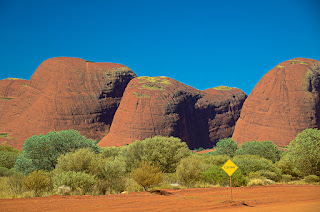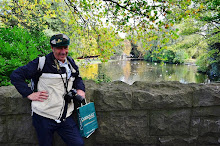KATA TJUTA (THE OLGAS)
THE AGONY AND THE ECSTACY – Words and pics by Ian Smith
The whole
trip hadn’t been about one thing, but if it had been, Valley of the Winds would
have been it. Of all the things I
planned to see, this was the most cherished.
I’d risen
early, heck, I was even under way before the sun reached over the horizon after
a night at Curtis Springs, some 100 kms distant from Uluru NP. I cruised along, anticipation building as I
conjured up things I might see today; excitement was in the air. I rocked up to the park entrance and got a
three day pass and soldiered on, pictures of Kata Tjuta flowing through my
brain and I took the turn off and saw the sign, “Valley Of The Winds –
CLOSED”. The red background of the sign
matched the colour of my complexion as expletive deleteds, in considerable
numbers, burst from my lips. I couldn’t
believe it; I was totally shattered, devastated and felt like my whole holiday
was in ruins.
At the
first lookout on the road I stopped and tried to make sense of it. There’d been no other warning, no reason
given forth; I could only assume that it was because the temperature seemed
like it would be hot and that Occ. Health and Safety had taken over. I moved off again until I reached the Valley
of the Winds carpark turn off and decided to go see what the problem was. Well, the problem was you couldn’t get a
park!
Here a
tourist bus, there two motorhomes, elsewhere a dozen 4WDs and a crested pigeon or two. I stopped and asked a tour guide what was
going on and referred to the sign. He
said it was open as far as he knew and said they often closed it at 11 a.m. on
hot days. I replied I understood that
but it was only 8.30 and obviously a lot of other people had driven past the
sign because they were coming in behind me.
Suddenly
my joy was manifest, my smile permanent, my enthusiasm bursting as I packed and
set off behind a small group.
Immediately
this walk has impact. There’s something
about these massive mounds of conglomerate that exude power and dominance. The embedded rocks are the size of a clenched
fist and bigger, apparently remnants of a landscape that was inundated by the
sea 600 million years ago before the whole thing was lifted and then eroded to
form the inselbergs we see today. Mount
Olga, at 1,066 metres, is around 110 metres taller from the surrounding plain
than Uluru and, up close and personal, it feels it.
Kata
Tjuta means many heads and the peak that sits beside you as you start out on
the trail has no apparent name and is 40 metres lower than Mount Olga. The walk is a rubber necker’s delight; you
have to keep gazing aloft in awe as the scenery sweeps you up in its grasp and
then you crest the first small rise and tempting glimpses of others come into the
scene beyond. The path then descends to
Kara Lookout where the distant domes can be better viewed but, already from
those on the trail, I’m hearing about the second lookout.
Just
after Kara the trail turns right, heading up a narrow canyon on a goat track
where a sometime waterfall is traversed.
Massive boulders carrying huge stones line up beside you, torn from the
mountain aeons ago. The dark stains of
the watercourses streak the cliffs and are in stark contrast to the orange
rocks; the holes from whence these boulders came add decorations to an already
mesmerizing vista.
Then
you’re turning left, moving steadily upwards, and noting yet another peak
looming on the right in this fertile canyon with its appropriate name. Valley
of the Winds. The air bursts through the
channel afforded it by the domes and bows the plants as it whistles by.
There’s
now a sense of anticipation as you near Karingana, the second lookout, and the
truly wonderful spectacle as you reach the top does not disappoint. Looking behind or in front will have you
shaking your head trying to take at least some of it in. There’s such a contrast in colour as well,
all dependent upon the time of day you’ve arrived. The distant domes are a brooding brown while
behind me the ochres of granite, gneiss and basalt are dazzling in the early
morning sun.
The steep
drop now takes you to the grassy plain below, utilizing the rough track until
it levels out and becomes a lot easier.
Here it’s a different world, less dramatic, perhaps more pretty but
still windblown. It sweeps around to the
left and continues up another incline until, looking far behind, you have clear
sweeping views of the band of lesser domes to the south, some of the 36 all
told. They appeared so bulbous from the
other side this morning at the viewpoint yet from here they appear as benign
bubbles floating on a sea of spinifex and desert oak.
Ahead
there’s a welcome drink station with cool H2O and shade and many stop here,
glad for the drink and glad for a reason to pause. I, too, relax and reflect and think how this
walk fulfilled my expectations and then some.
I never thought I’d do a walk in Australia that would rival those done
in Karijini, but this one certainly did.
Most of
the 2.6 kms back to the carpark goes over the initial path and my legs aren’t
too happy after days of endless rocky paths and inclines, but there’s still
Uluru to go after I duck into Walpa Gorge, which turns out to be a bit of a
non-event after Valley of the Winds.
















0 Comments:
Post a Comment
<< Home